Queensland |
||||||||||||||||||||||||||||||||||||||||||||||||||||||||||
 |
 |
|||||||||||||||||||||||||||||||||||||||||||||||||||||||||
Crocheted dress with raglan, lace pattern and short sleeves, worked top down. Sizes S - XXXL. The piece is worked in DROPS Safran.
DROPS 186-12 |
||||||||||||||||||||||||||||||||||||||||||||||||||||||||||
|
INFORMATION FOR THE PATTERN: CROCHET INFO: On beginning of each round with treble crochets replace first treble crochet with 3 chain stitches. The round finishes with 1 slip stitch in the 3rd chain stitch at the beginning of the round. INCREASE/DECREASE TIP (evenly spaced): To work out how to increase/decrease evenly, count the total number of stitches on the round (e.g. 114 stitches) and divide by the number of increases/decreases to be made (e.g. 29) = 3.9. In this example, increase in approx. every 4th stitch – read INCREASE TIP. When decreasing, crochet every 3rd and 4th stitch together – read DECREASE TIP. INCREASE TIP: Increase 1 treble crochet by working 2 treble crochets in the same stitch. DECREASE TIP: Decrease 1 treble crochet by working the next 2 treble crochets together as follows: Work 1 treble crochet, but wait with the last yarn over and pull through (= 2 loops on hook), work the next treble crochet, but when working the last pull through, pull the strand through all 3 loops on the hook. PATTERN: See diagrams A.1 to A.5. ---------------------------------------------------------- DRESS: The piece is worked in the round, top down. NECK: Work 114-118-124-128-132-136 slightly loose chain stitches with hook size 3.5 mm and Safran and form them into a ring with 1 slip stitch in the first chain stitch. ROUND 1: Work 2 chain stitches (equivalent to 1 half treble crochet), then work 1 half treble crochet in each chain stitch to end of round, finish the round with 1 slip stitch in the 2nd chain stitch at the beginning of the round = 114-118-124-128-132-136 half treble crochets. ROUND 2: Work 3 chain stitches (equivalent to 1 half treble crochet + 1 chain stitch), skip 1 half treble crochet, * work 1 half treble crochet in the next half treble crochet, 1 chain stitch, skip 1 half treble crochet *, work from *-* to end of round and finish with 1 slip stitch in the 2nd chain at the beginning of the round = 114-118-124-128-132-136 stitches on round. ROUND 3: Work 3 chain stitches (equivalent to 1 treble crochet), then work 1 treble crochet in each half treble crochet and 1 treble crochet around each chain stitch – AT THE SAME TIME increase 29-25-30-26-33-29 treble crochets evenly on round – read INCREASE/DECREASE TIP and INCREASE TIP = 143-143-154-154-165-165 treble crochets. Finish the round with 1 slip stitch in the 3rd chain stitch at the beginning of the round. Read CROCHET INFO and work A.1 in the round (= 13-13-14-14-15-15 repeats of 11 stitches). On the last round in A.1 you will, for the most part, work 15 treble crochets in each repeat, but in 5-5-6-10-7-11 repeats evenly spaced on the round, increase this to 16 treble crochets so that the total is 200-200-216-220-232-236 treble crochets on the round. The piece now measures approx. 7 cm from the cast-on edge. Now work yoke as described below. REMEMBER THE CROCHET TENSION! YOKE: Work 1 round of treble crochets with 1 treble crochet in each treble crochet. Then insert 4 marker threads in the piece as follows (without working the stitches): Count 34-34-38-39-42-43 treble crochets (= ½ back piece), insert 1 marker thread in the next treble crochet, count 30 treble crochets (= sleeve), insert 1 marker thread in the next treble crochet, count 68-68-76-78-84-86 treble crochets (= front piece), insert 1 marker thread in the next treble crochet, count 30 treble crochets (= sleeve), insert 1 marker thread in the next treble crochet. There are 34-34-38-39-42-43 treble crochets left on the round after the last treble crochet with marker thread. Continue working treble crochets in the round with 1 treble crochet in each treble crochet - AT THE SAME TIME increase to raglan at each marker thread as follows: ROUND 1: Work 1 treble crochet + 2 chain stitches + 1 treble crochet in each treble crochet with a marker thread (= 4 treble crochets increased on the round) = 204-204-220-224-236-240 treble crochets on the round. ROUND 2: Around each chain-space with 2 chain stitches work 1 treble crochet + 2 chain stitches + 1 treble crochet (= 8 treble crochets increased on round) = 212-212-228-232-244-248 treble crochets on round. Repeat round 2 until you have worked a total of 9-13-15-18-20-23 rounds with increases (including the increases in round 1) = 268-300-332-360-388-416 treble crochets on the round. On the next round work 1 treble crochet in each treble crochet, but around each chain-space with 2 chain stitches work 2 treble crochets (= 8 treble crochets increased on the round) = 276-308-340-368-396-424 treble crochets on the round. Continue to work treble crochets without increases until the piece measures 19-21-23-25-27-29 cm from the cast-on edge mid front. The next round is worked as follows: Work 40-44-48-53-59-65 treble crochets (including the 3 chain stitches at beginning of round = ½ back piece), work 8-8-10-10-12-14 slightly loose chain stitches, skip 58-66-74-78-80-82 treble crochets (= sleeve), work 80-88-96-106-118-130 treble crochets (= front piece), work 8-8-10-10-12-14 slightly loose chain stitches, skip 58-66-74-78-80-82 treble crochets (= sleeve) and work the last 40-44-48-53-59-65 treble crochets on the round (= ½ back piece). Cut the strand. Body and sleeves are finished separately. THE PIECE IS NOW MEASURED FROM HERE! BODY: Insert 1 marker in the middle of the 8-8-10-10-12-14 chain stitches under the sleeve on the one side of the piece and start the round here. Work 1 double crochet in the first chain stitch, 3 chain stitches (equivalent to 1 treble crochet), then work 1 treble crochet in each chain stitch and 1 treble crochet in each treble crochet to end of round = 176-192-212-232-260-288 treble crochets. Continue in the round with treble crochets. When the piece measures 2 cm from the separation, decrease 8-8-8-10-10-10 treble crochets evenly on round = 168-184-204-222-250-278 treble crochets – read INCREASE/DECREASE TIP. Repeat the decrease when the piece measures 6 cm from the separation = 160-176-196-212-240-268 treble crochets. When the piece measures 12 cm from the separation, increase 12-12-12-14-14-14 treble crochets evenly on round = 172-188-208-226-254-282 treble crochets. When the piece measures 18 cm from the separation, increase 12-12-12-14-14-14 treble crochets evenly on round = 184-200-220-240-268-296 treble crochets. When the piece measures 26 cm from the separation, increase 14 treble crochets evenly on round in all sizes = 198-214-234-254-282-310 treble crochets. When the piece measures 34 cm from the separation, increase 14 treble crochets evenly on round in all sizes = 212-228-248-268-296-324 treble crochets. When the piece measures 40-41-42-43-44-45 cm from the separation, (the piece now measures approx. 62-65-68-71-74-77 cm from the shoulder) increase 40-48-40-44-40-48 treble crochets evenly on round = 252-276-288-312-336-372 treble crochets. Work A.2 in the round (= 21-23-24-26-28-31 repeats of 12 stitches). AT THE SAME TIME on the last round in A.2 increase 52-60-64-72-64-60 treble crochets evenly on round = 304-336-352-384-400-432 treble crochets. Work A.3 in the round (= 19-21-22-24-25-27 repeats of 16 stitches). When A.3 has been completed, there are 475-525-550-600-625-675 treble crochets on the round. Now work A.X as shown in A.2 (= 2 rounds). AT THE SAME TIME on the last round increase 30-28-39-25-36-34 treble crochets evenly on round = 505-553-589-625-661-709 treble crochets. The next round is worked as follows: A.4A (= 6 stitches), work A.4B over the next 492-540-576-612-648-696 treble crochets (= 41-45-48-51-54-58 repeats of 12 stitches), finish with A.4C (= 7 stitches). When A.4 has been completed, cut and fasten the strand. The dress measures approx. 92-95-98-101-104-107 cm from the shoulder down. SLEEVE: Insert 1 marker in the middle of the 8-8-10-10-12-14 chain stitches under the sleeve on the one side of the piece and start the round here. Work 1 double crochet in the first chain stitch, 3 chain stitches (equivalent to 1 treble crochet), then work 1 treble crochet in each chain stitch and 1 treble crochet in each treble crochet to end of round = 66-74-84-88-92-96 treble crochets. Work 1 round of treble crochets where you decrease 6-2-12-4-8-0 treble crochets evenly on round = 60-72-72-84-84-96 treble crochets. Work A.5 in the round (= 5-6-6-7-7-8 repeats of 12 stitches). When there are 3 rounds left in A.5 change to hook size 3 mm. Finish working A.5, cut and fasten the strand. The sleeve measures approx. 8 cm from the separation. Work the other sleeve in the same way. |
||||||||||||||||||||||||||||||||||||||||||||||||||||||||||
Diagram explanations |
||||||||||||||||||||||||||||||||||||||||||||||||||||||||||
|
||||||||||||||||||||||||||||||||||||||||||||||||||||||||||
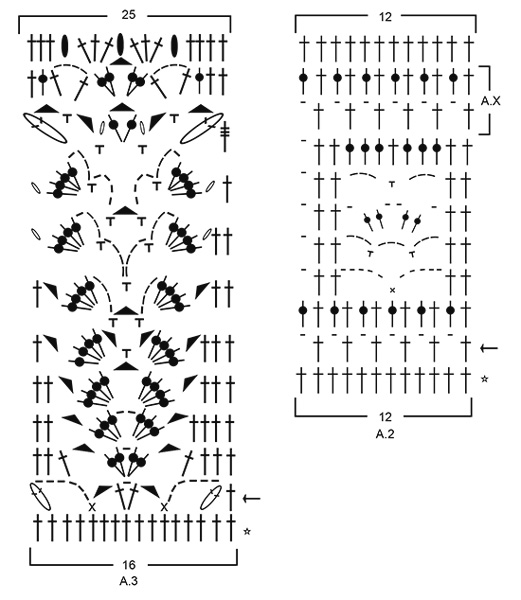
|
||||||||||||||||||||||||||||||||||||||||||||||||||||||||||
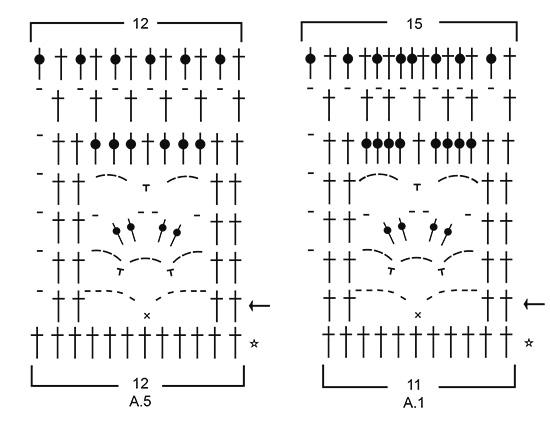
|
||||||||||||||||||||||||||||||||||||||||||||||||||||||||||

|
||||||||||||||||||||||||||||||||||||||||||||||||||||||||||
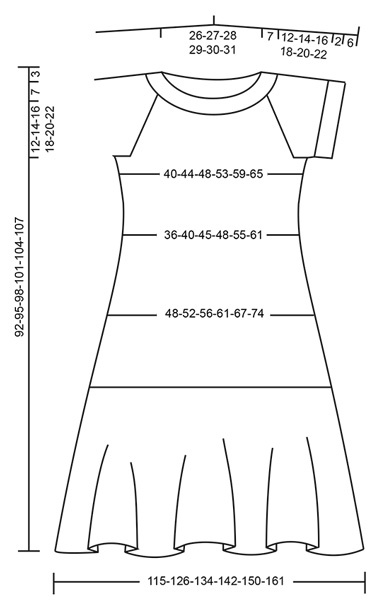
|
||||||||||||||||||||||||||||||||||||||||||||||||||||||||||
|
Have you made this or any other of our designs? Tag your pictures in social media with #dropsdesign so we can see them! Do you need help with this pattern?You'll find tutorial videos, a Comments/Questions area and more by visiting the pattern on garnstudio.com. © 1982-2024 DROPS Design A/S. We reserve all rights. This document, including all its sub-sections, has copyrights. Read more about what you can do with our patterns at the bottom of each pattern on our site. |
||||||||||||||||||||||||||||||||||||||||||||||||||||||||||

































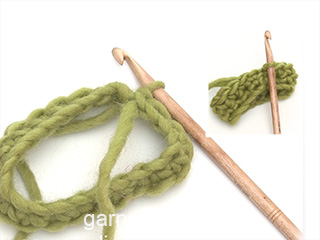
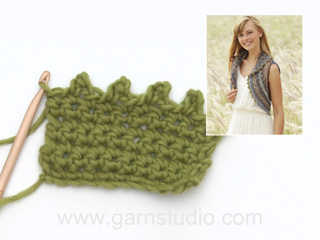























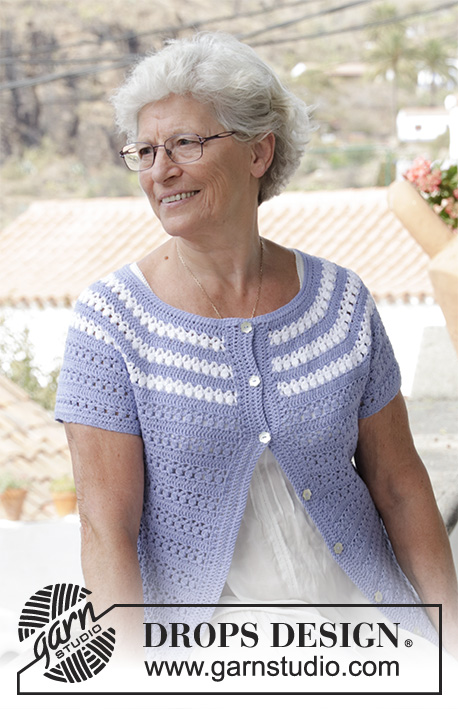
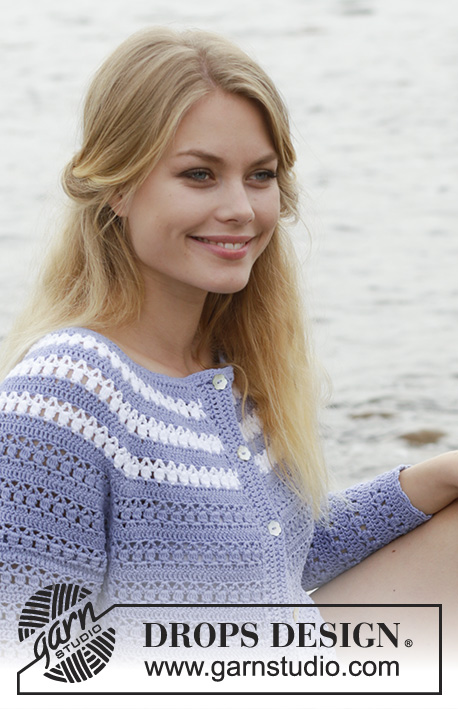






Comments / Questions (60)
Disregard my previous query, I have gone back to row 2 of A1 and realised that I put some stitches into the incorrect space.
25.08.2022 - 03:10Neck query: Second last row of neck, my stitch count is correct - 143 stitches for second size, but I only have 11 repeats. When I do the last row of A1, I definitely do not get 200 hundred stitches. I really cannot see where I’ve gone wrong. Please help.
25.08.2022 - 02:49DROPS Design answered:
Dear Gail, read A.1 bottom up, ie start A.1 over 11 stitches and repeat 13 times the diagram in width over the 143 sts. On the last row in A.1 you will increase to 15 sts in each A.1 x 13 repeats = 195 sts and increase evenly 5 sts on last row = 195+5=200 sts. Happy crocheting!
25.08.2022 - 09:39Why do the beginning of round chain 4 stitches alternate between A4a and A4c if the pattern is crochet in round? They should all be in A4a as that is where the round begins! Right now it looks like the chart is to be read back and forth
17.08.2022 - 22:18Hej !håller på med klänningen o tycker det inte blir så snyggt med varvbyte mitt bak så undrar om ni har nåt tips eller är det bara o gilla läget ?
28.07.2022 - 10:07DROPS Design answered:
Hej Marie, det findes lidt forskellige videoer hvordan man undgår hak ved varvbyte. Her ser du hvordan vi gør: Virka runt med stolpar
04.08.2022 - 09:50I'm struggling to understand A4 and where each row finishes and the next one starts. Could you please clarify ?
21.07.2022 - 22:45DROPS Design answered:
Dear Kate, at the beginning of the row/ round you work A.4A once. Then, repeat A.4B, when you reach the last stitch of A.4B return to the first one and work A.4B again. Repeat A.4B until 7 stitches remain in row/ round. Then, work A.4C once over these 7 stitches. Happy knitting!
24.07.2022 - 17:26Hallo, wird immer von der rechten Seite gehäkelt oder nach jeder Runde gewendet.?
30.03.2022 - 15:22DROPS Design answered:
Liebe Frau Grosse, dieses Kleid wird in Runden (immer von der rechten Seiten) gehäkelt. Viel Spaß beim häkeln!
30.03.2022 - 16:18Leider verstehe ich den Rechenweg noch immer nicht. Ich starte mit 236Stäbchen. An jeder Markierung nehme ich 2Stäbchen zu (=8Stäbchen je Runde). Am Ende von Runde 1 also 244Stäbchen. Somit in R2 = 252Stb. R3 = 260, usw. Ich verstehe nicht, wie in Runde 1 lediglich 4Stäbchen zugenommen werden wenn es je Ecke 2 Stäbchen Zunahme sind?\r\nKönnen Sie das bitte genauer erklären?\r\nDanke und viele Grüße
16.11.2021 - 22:20DROPS Design answered:
Liebe Marie M, wenn Sie in 1 Masche (1 Stb, 2 Lm, 1 Stb) häkeln, nehmen Sie nur jeweils 1 Stb (= Mal 4 = 4 Stb in der Runde), aber wenn Sie dann um den Luftmaschenbogen 1 Stb, 2 Lm, 1 Stb häkeln, dann nehmen Sie jeweils 2 Stb (einfach weil Sie um den Luftmaschenbogen und nicht in einer Masche häkeln), ist das klarer?
17.11.2021 - 07:59Ich bin gerade bei der Passe angekommen und habe auch schon markiert. Allerdings brauche ich jetzt Hilfe! Es steht in Runde 1 an jeder Markierung 1Stb 2LM 1Stb bedeutet eine Zunahme von 2 Stäbchen je Ecke also in der Runde 8Stb. Am Ende wären es ja bei XXL dann aber 244 anstatt 240 wie in der Anleitung. Ebenfalls in den Folgerunden. Können Sie mir das bitte erklären, wie es richtig gemacht wird?\r\nDanke und viele Grüße
15.11.2021 - 22:14DROPS Design answered:
Liebe Marie M, vor der 1. Runde haben Sie 232 M, dann häkeln Sie 1 Stb+2 Lm+1 Stb in je 1 Masche x 4 (= 4 Zunahmnen ) = 236 Stb; dann häkeln Sie 1 Stb + 2 Lm + 1 Stb um den Luftmaschenbogen = 2 Stb werden jeweils zugenommen = 8 Stb insgesamt = 236+8=244 Stb. Viel Spaß beim häkeln!
16.11.2021 - 09:26Hei. Jeg er kommet til berestykket der jeg skal sette inn fire merker. Jeg har bare 231 masker etter A1 mønster (lager størrelse xxxl), men jeg greier ikke å forstå hvor jeg har glemt å øke.. har økt i omgang 3 og i siste stmaskerad i A1..
29.09.2021 - 22:33DROPS Design answered:
Hej Malin. När A.1 är heklet 1 gang på höjden så ska du ha 15 staver i hver rapport, men i 11 av dessa ska du öka så att du har 16 staver istället. Dvs att du har totalt 15 rapporter på omgangen och 4 av dessa består av 15 staver och 11 av dessa består av 16 staver. (4 x 15) + ( 11 x 16) = 236 staver. Hoppas det är till hjälp. Mvh DROPS Design
30.09.2021 - 10:38I am not understanding how A4 section is worked. Is this section turned and worked back and forth or is it supposed to be done in the round? With the chain 4 appearing at opposite sides in the graph it appears that this would be turned after the completion of each round.
01.08.2021 - 17:48DROPS Design answered:
Dear Jacqueline, A.4 is done on the round just as well as all the other parts of the piece. Happy Stitching!
02.08.2021 - 01:11